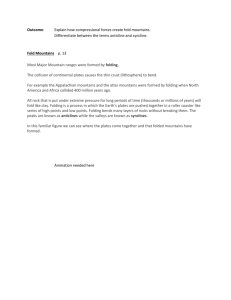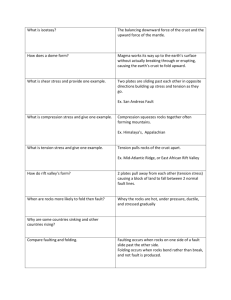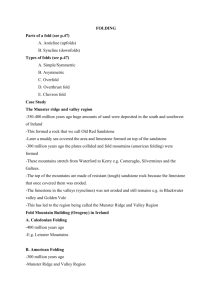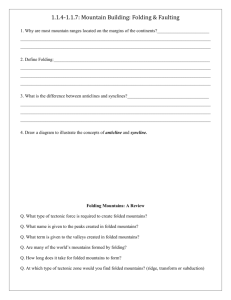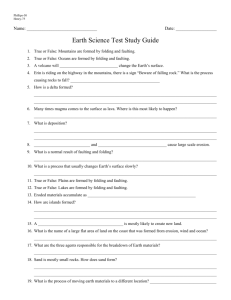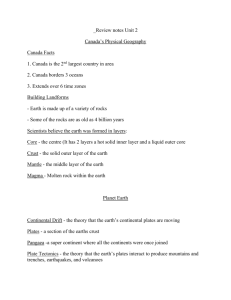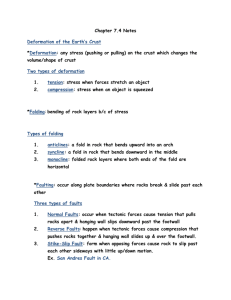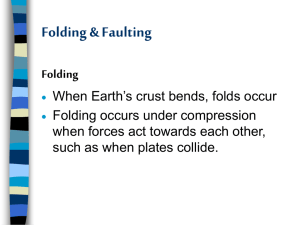Folding and Faulting
advertisement
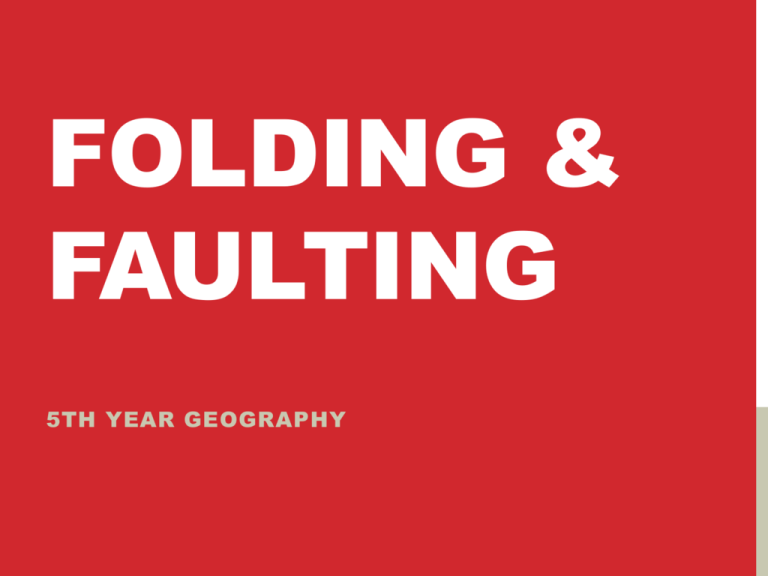
FOLDING & FAULTING 5TH YEAR GEOGRAPHY LEARNING OUTCOME Examine how sedimentary rocks are affected by folding Review the three periods of fold mountain building Understand structures of deformation; • Folding • Doming • Faulting ROCKS CAN CHANGE SHAPE DUE TO STRESS KEY TERM Orogeny The forces and events leading to the structural deformation of the Earth’s Crust due to plate movement. Orogeny results in mountain building. FOLDING Rock layers bend due to stress Most rocks are laid down horizontally Compression Rock buckled Appears as folds on the landscape Layers of sedimentary rock pushed upwards- Anticlines Layers pushed downwardsSynclines ANTICLINES & SYNCLINES SYNCLINE FOLDING Associated with the closing of oceans Continental plates collide with each other Compresses the sedimentary rocks that are on the seabed 4 TYPES OF FOLD •Simple •Asymmetrical •Overfold •Overthrust THREE PERIODS OF FOLD MOUNTAIN BUILDING Caledonian Armorican Alpine CALEDONIAN FOLDING • 400 million years ago • American & Eurasian plates collided / converged • Closed the Iapetus Sea • Formation of Fold Mountains • Eg; West Ireland- Nephin Beg Mountains • Dublin & Wiclow Mountains • Scottish Highlands • Igneous and Metamorphic rock also formed • Magma moved up through faults ARMORICAN FOLDING •250 million years ago •Eurasian & African plates collided / converged •Munster Ridge & Valley landscape formed •Formation of Fold Mountains • Eg; Macgillicuddy Reeks • Comeragh Mountains • Pyrenees, France ALPINE FOLDING •60 million years ago •Did not affect Ireland •Eurasian & African plates collided / converged •Formation of Fold Mountains • Eg; Alps • Appennines, Southern Italy EXAM QUESTION DOMING DOMING 2 Types; -When rising magma raises rock upwards -The result of compression Eg; Slieve Bloom Mountains, Laois/Offaly FAULTING •Faults are caused by plate movement •The movement may be vertical, horizontal or both •It causes the rocks within the earths crust to experience stress •A fracture occurs along a line of weakness in the rock NORMAL FAULTS •Constructive plate boundaries •Tension, crust stretches •Rocks fracture along fault line •Downward movement of land NORMAL FAULTS • Two or more parallel faults •Block of land moves down •Rift Valley / Graben EAST AFRICAN RIFT VALLEY NORMAL FAULTS • Compression can cause land between two parallel faults to be pushed upwards •Block Mountain OX MOUNTAINS, SLIGO REVERSE FAULTS •Destructive plate boundaries •Compression within the crust •Rocks fold upwards •Crust fractures •Land moves upwards TEAR / TRANSFORM FAULTS • Plates slide past each other •Crust is neither created or destroyed •Stress builds up in the two plates •Shearing can occur •The crust is fractured along a fault line SAN ANDREAS FAULT •Tear / Transform Fault •1300 km long •North American & Pacific Plates •California PAIR-WORK REVISION QUESTIONS 1. Where is folding most likely to occur? 2. What is Orogeny? 3. Give an example of mountains formed during the Caledonian period. 4. Explain the two ways domes can form. 5. Name a dome structure found in Ireland. 6. What causes faulting? 7. List the three types of fault. 8. Explain how a rift valley occurs. EXAM QUESTION EXAM QUESTIONS
